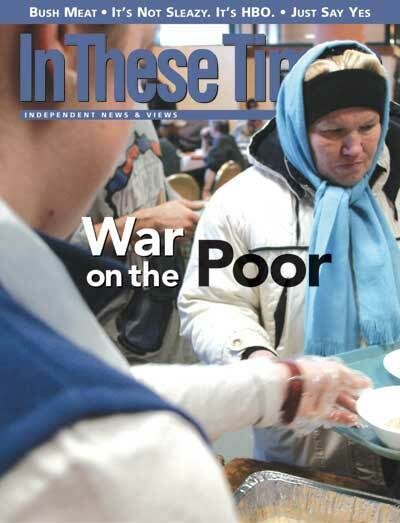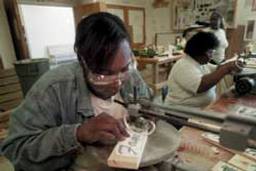Eti Goari is Jewish, 38, wears her hair black with gold highlights, and immediately and enthusiastically declares “cain!” (yes!) when asked if she is a good cook. She has never been blown up while riding a bus. She lives removed from the West Bank in the coastal town of Nahariya, above Haifa—but she is a victim of Israel’s occupation of Palestine.
A year ago the boss at a catering company laid off Goari, forcing her and her 10-year-old son on the dole. She received roughly 2,100 shekels per month, she says, or $470. That fell to about $337 in June—a 28 percent hit—thanks to draconian budget cuts designed by Ariel Sharon’s conservative Finance Minister, Benjamin Netanyahu.
With the Israeli economy reeling and tax revenues dried up, the Sharon government slashed social services last spring without touching defense spending. Benefits like children’s allowances, old-age pensions and income support payments suffered a $2.3 billion reduction.
As Netanyahu moves forward with his cuts, the Histadrut—Israel’s trade union federation—has become the most visible group organizing against them. In April, the union put some 70,000 people onto the streets in protest. Severely weakened in membership and finances over the past decade, the Histadrut’s ability to counter this latest assault against Israeli workers will be a test of the organization’s strength.
Not only is Israel’s occupation of the West Bank and Gaza a human rights horror, it is an enormous drain on the national budget. In 2002, spending on the Israeli security apparatus took 20 percent of the budget, according to the Finance Ministry, and that does not include subsidies for Jewish settlements in Arab territories.
Despite the undeniable connection between the cost of occupation and the social service cuts, the federation’s leadership steadfastly refuses to take a political position on Palestine. But a faction of Histadrut members are advocating for a strong stand against the occupation in Palestine. While not formally organized, they are not hiding their views and must contend with a leadership that fears splitting its membership, many of whom still vote Sharon’s party, Likud, for security reasons.
“When they are inside the room, many [Histadrut] leaders agree,” and oppose the occupation, says Jihad Akel, deputy chairman of the Histadrut’s Trade Union Department and member of the union’s executive committee. “But when they come to the public, they don’t have the courage to say it.”
The federation offered an alternate budget plan to the one put forth by Netanyahu. Yet nowhere in the plan did the union highlight defense spending. Instead the Histadrut focused on measures like improving collection of value-added taxes on undeclared transactions, Akel says.
Efraim Zilony, chairman of the Histadrut’s Economic and Social Authority, says the Histadrut discusses the occupation in economic rather than political terms. “We say [that] we know that sooner or later … there is a time we shall have to live in peace with the Palestinians,” says Zilony, “and we have [to] make great concessions—so why do we have to put money in these territories?”
Zilony is affiliated with Meretz, a political party directly to the left of Labor, while Akel belongs to Hadash, an outgrowth of the Israeli communist party. The Histadrut’s general secretary, Amir Peretz, a dove, heads his own left-leaning faction in the Israeli parliament, and the goal of activists like Akel is to push Peretz into a more definitive position from inside the organization.
According to Dan Jacobson, a labor professor at Tel Aviv University, the effort could be aided by Peretz’s national ambitions. Peretz has been in negotiations to fold his party and join Labor, perhaps as its leader. In his campaigning Peretz has stuck to workers rights issues, but for him to become a true national leader, he will have to become a multi-dimensional candidate—a shift that may mean taking a definitive position on Palestine.
In the meantime, the Israeli union remains far from a strong voice of dissent on the occupation.
A year ago the boss at a catering company laid off Goari, forcing her and her 10-year-old son on the dole. She received roughly 2,100 shekels per month, she says, or $470. That fell to about $337 in June—a 28 percent hit—thanks to draconian budget cuts designed by Ariel Sharon’s conservative Finance Minister, Benjamin Netanyahu.
With the Israeli economy reeling and tax revenues dried up, the Sharon government slashed social services last spring without touching defense spending. Benefits like children’s allowances, old-age pensions and income support payments suffered a $2.3 billion reduction.
As Netanyahu moves forward with his cuts, the Histadrut—Israel’s trade union federation—has become the most visible group organizing against them. In April, the union put some 70,000 people onto the streets in protest. Severely weakened in membership and finances over the past decade, the Histadrut’s ability to counter this latest assault against Israeli workers will be a test of the organization’s strength.
Not only is Israel’s occupation of the West Bank and Gaza a human rights horror, it is an enormous drain on the national budget. In 2002, spending on the Israeli security apparatus took 20 percent of the budget, according to the Finance Ministry, and that does not include subsidies for Jewish settlements in Arab territories.
Despite the undeniable connection between the cost of occupation and the social service cuts, the federation’s leadership steadfastly refuses to take a political position on Palestine. But a faction of Histadrut members are advocating for a strong stand against the occupation in Palestine. While not formally organized, they are not hiding their views and must contend with a leadership that fears splitting its membership, many of whom still vote Sharon’s party, Likud, for security reasons.
“When they are inside the room, many [Histadrut] leaders agree,” and oppose the occupation, says Jihad Akel, deputy chairman of the Histadrut’s Trade Union Department and member of the union’s executive committee. “But when they come to the public, they don’t have the courage to say it.”
The federation offered an alternate budget plan to the one put forth by Netanyahu. Yet nowhere in the plan did the union highlight defense spending. Instead the Histadrut focused on measures like improving collection of value-added taxes on undeclared transactions, Akel says.
Efraim Zilony, chairman of the Histadrut’s Economic and Social Authority, says the Histadrut discusses the occupation in economic rather than political terms. “We say [that] we know that sooner or later … there is a time we shall have to live in peace with the Palestinians,” says Zilony, “and we have [to] make great concessions—so why do we have to put money in these territories?”
Zilony is affiliated with Meretz, a political party directly to the left of Labor, while Akel belongs to Hadash, an outgrowth of the Israeli communist party. The Histadrut’s general secretary, Amir Peretz, a dove, heads his own left-leaning faction in the Israeli parliament, and the goal of activists like Akel is to push Peretz into a more definitive position from inside the organization.
According to Dan Jacobson, a labor professor at Tel Aviv University, the effort could be aided by Peretz’s national ambitions. Peretz has been in negotiations to fold his party and join Labor, perhaps as its leader. In his campaigning Peretz has stuck to workers rights issues, but for him to become a true national leader, he will have to become a multi-dimensional candidate—a shift that may mean taking a definitive position on Palestine.
In the meantime, the Israeli union remains far from a strong voice of dissent on the occupation.






